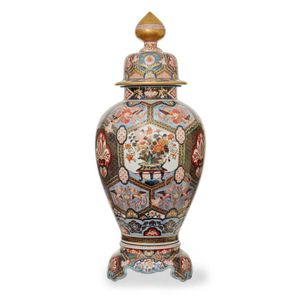Imari Octagonal Vase with Silver Finial
You must be a subscriber, and be logged in to view price and dealer details.
Subscribe Now to view actual auction price for this item
When you subscribe, you have the option of setting the currency in which to display prices to $Au, $US, $NZ or Stg.
- Finial - An architectural decoration, found on the upper parts of of an object. On furniture they are usually found on pediments, canopies and shelf supports. On smaller ceramic or silver items, such as spoons, they may decorate the top of the item itself, or the lid or cover where they provide a useful handle for removal.
Finials have a variety of shapes and forms. They may be urn-shaped, baluster shaped round or spiral, but usually taper into an upper point. Many real life shapes may also be used as finials, such as pineapples, berries, pinecones, buds, lotus and acorns. Sometimes animals such as a lion are depicted, or fish and dolphins. - Edo Period, Japan - The Edo period in Japan lasted from 1603 to 1868. During this time, Japan was ruled by the Tokugawa shogunate, a military government led by the Tokugawa family. The Edo period is characterized by a period of relative peace, stability, and economic growth, as well as by the development of a distinctive culture and society.
During the Edo period, the capital of Japan was moved from Kyoto to Edo (modern-day Tokyo), and the country became increasingly isolated from the rest of the world. The shogunate implemented strict policies to maintain control, including the restriction of foreign trade and travel. However, despite this isolation, the Edo period saw significant cultural and artistic development, including the emergence of the ukiyo-e woodblock print tradition, the growth of Kabuki theater, and the flourishing of a vibrant merchant culture.
The Edo period ended with the Meiji Restoration of 1868, which saw the collapse of the shogunate and the restoration of imperial rule.
This item has been included into following indexes:
- Japanese ceramics, styles and decoration - Imari, vases and urns, lidded 41
-
Satsuma (Japan), item type
- other items 2,034
- vases 1,376
Visually similar items

An impressive pair of floor standing Imari lidded urns each decorated in typical form, with a fo dog finial, 152 cm high (one illustrated)

A Japanese Imari covered vase, gilt and polychrome Enamels 19th/20th century, large and impressive Imari covered vase of baluster form with very fine polychrome enamel work, with background of tortoise shell and traditional wave design, the main cartouche

An impressive covered Japanese floor vase in the Imari palette, Meiji period, 19th century, large and impressive Imari floor vase of baluster form decorated in underglaze blue and overglaze iron red and polychrome HO-o birds, landscapes and spaced by furth

A Japanese Imari covered vase, gilt and polychrome Enamels, 19th/20th century, large and impressive Imari covered vase of baluster form with very fine polychrome enamel work, with background of tortoise shell and traditional wave design, the main cartouche
